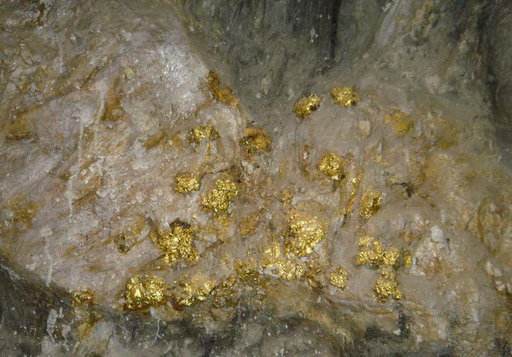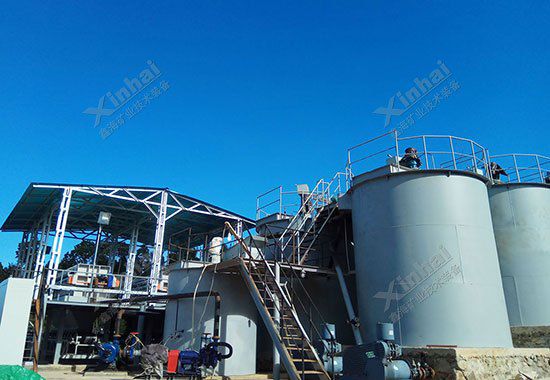Gold is a rare and precious metal. With people's continuous exploration and efforts, the world's gold production reached 3534 tons in 2019. However, with the continuous mining operation of gold mines, most left mines are refractory gold mines. Here is an introduction to why it’s difficult to separate some gold ores? And what separation process should we use to deal with refractory gold ores?

1. Gold of physical encapsulation
There are two types of refractory gold ores, namely physical encapsulation and chemical interference gold ore. Physically encapsulated gold ore refers to the gold that is dispersed on other host minerals in the form of fine-grained or sub-granular dissemination or encapsulation. Common encapsulated gold is pyrite, arsenopyrite (arsenopyrite), copper, money, zinc sulfides. While some encapsulated gold exists in quartzite and sulfate. The second type is rare and there is no good way to recover it now.
Physical encapsulation is the main and important type of refractory gold ore at present, and it is also a type of refractory gold ore that is widely studied. It is worth noting that the main minerals that contain gold, such as pyrite and arsenopyrite, are also one of the main factors that cause chemical interference.
2. Gold of chemical interference
Chemical interference refers to the complex chemical composition of gold ore and the complex occurrence state of gold, which leads to chemical interference to cyanidation leaching. For example, the existence of oxygen-consuming, cyanide-consuming and gold-absorbing substances in the ore will result in chemical interference on cyanide leaching. Chemical interference of gold mainly includes the following six kinds:
(1) There are various sulfide minerals in gold-bearing ores that consume fluoride, which is a toxic substance;
(2) There are minerals in the ore that consume oxygen during decomposition. Oxygen consumption will lead to oxygen deficiency during cyanidation, which will affect the cyanidation leaching of gold;
(3) There are carbonaceous substances in the ore that can adsorb dissolved gold complexes, and their properties are similar to activated carbon, causing the phenomenon of "robbing gold". Only after roasting and destroying the crystal structure can the chemical reaction be carried out. For carbon-bearing minerals, due to the strong adsorption effect of the ore, the gold in the ore heap has been taken away by the carbon, and this process is similar to the extraction of gold by activated carbon.
(4) Arsenic, antimony, lead and other minerals in the ore dissolve to form certain compounds or colloids that are adsorbed on the surface of gold particles to form a protective film, which hinders the leaching of gold;
(5) Gold exists in the form of insoluble gold-containing compounds or compounds;
(6) When gold is in contact with other conductive minerals, the anodic dissolution of gold is passivated.

According to the process mineralogy characteristics of refractory gold ore, the methods to improve the effect of refractory gold ore processing are as follows:
(1) Mechanically crush the inclusions to dissociate the gold, such as crushing and grinding the refractory gold ore with a crusher and a ball mill, so that the degree of dissociation of the monomer is higher.
(2) Pre-treatment before cyanidation aims to oxidatively decompose the host minerals to dissociate the encapsulated gold and remove some interfering components, such as oxidative roasting, pressure leaching and bacterial leaching.
(3) Adopt non-cyanide leaching method to avoid the adverse effects of substances that interfere with the annealing process, such as thiosulfate or sulfur vein leaching.
(4) Strengthen or improve the cyanidation process, such as pressurized cyanidation, cyanidation with oxidizing agents, adding certain chemical substances to shield or eliminate the interference of harmful components on cyanidation.
In recent years, the number of gold mines using the technology of processing refractory ore has grown rapidly. From the actual situation of research and production, the commonly used processes are mainly oxidative roasting, pressure oxidation and bacterial pre-oxidation process.
At present, it is a worldwide problem for how to separate sulfide ores with high arsenic, high sulfur and high carbon, and it will also be a new research direction of gold extraction technology in the future. The high-arsenic, high-carbon and fine-grained disseminated gold deposits discovered in the Yunnan-Guizhou-Sichuan region of China have a prospective gold reserve of several hundred tons. It is hoped that the future technology can extract gold well and benefit mankind.